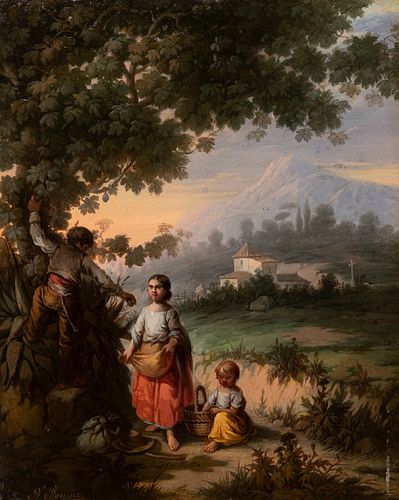Spanish School; Mid-twentieth century. "Picking figs". Oil on panel.
Lot 37
About Seller
Setdart Auction House
Carrer Aragó 346
Barcelona
Spain
Setdart Subastas was born in 2004 and is currently the first online art auction in Spain with solidity, prestige and reliability guaranteed by our more than 60,000 users. Setdart has a young, dynamic and enterprising team ready to successfully manage the purchase and sale of art works through custom...Read more
Estimate:
EUR€1,500 - EUR€2,000
$1,612.90 - $2,150.54
Absentee vs Live bid
Two ways to bid:
- Leave a max absentee bid and the platform will bid on your behalf up to your maximum bid during the live auction.
- Bid live during the auction and your bids will be submitted real-time to the auctioneer.
Bid Increments
| Price | Bid Increment |
|---|---|
| EUR€0 | EUR€10 |
| EUR€200 | EUR€25 |
| EUR€500 | EUR€50 |
| EUR€1,000 | EUR€100 |
| EUR€3,000 | EUR€200 |
| EUR€5,000 | EUR€500 |
| EUR€10,000 | EUR€1,000 |
| EUR€20,000 | EUR€2,000 |
| EUR€50,000 | EUR€5,000 |
About Auction
By Setdart Auction House
Nov 10, 2021
Set Reminder
2021-11-10 08:00:00
2021-11-10 08:00:00
America/New_York
Bidsquare
Bidsquare : 19th & 20th Century paintings and Decorative Arts
https://www.bidsquare.com/auctions/setdart-auction-house/19th-20th-century-paintings-and-decorative-arts-7800
Setdart Auction House sofia@setdart.com
Setdart Auction House sofia@setdart.com
- Lot Description
Spanish School; Mid-twentieth century. "Picking figs". Oil on panel. Preserves period frame. Signed in the lower left corner. Measurements: 26.5 x 21.5 cm; 42 x 37 cm (frame). Peacefully some children pick figs in a deep landscape. The author shows the kind face when reflecting the innocence of some young people who collaborate between them to gather food. The three children have a relevant role in the task, even the youngest, who holds the basket and seems to place the fruit inside. The landscape of the scene is also the protagonist, since the author opens the view of the space, placing a foreground where the main scene takes place, followed by successive shots that reach the mountains behind the village. It is a painting that can be framed in the aesthetic parameters developed by the current of costumbrismo. The new genre painting of the nineteenth century was born as a way of interpreting a growing sense of national consciousness, now present in the middle class as it advanced towards social hegemony. To a certain extent, the painters' concern was to deepen the vision of their country through a language, that of painting, that everyone could understand, thus helping the common people to understand the nature and meaning of their nationality, especially as it had manifested itself in the recent past, still alive in the memory of the elders. Of the two fundamental costumbrista schools of 19th century Spain, the Sevillian and the Madrilenian, the latter differs from the kindly picturesqueness of the former in its more pungent and harsh vision, sometimes going so far as to show not only the vulgar, but even recreating itself in torn visions of a clichéd world of the slums, in which the spirit of criticism is evident. In the present case, we find an urban scene where you can see bourgeois style buildings and several characters with clothes of the time, carriages, etc.. It is a scene that we could define as idyllic, rich, delicate, gentrified.
- Shipping Info
-
In-house shipping available. Please inquire at admin@setdart.com.
-
- Buyer's Premium



 EUR
EUR CAD
CAD AUD
AUD GBP
GBP MXN
MXN HKD
HKD CNY
CNY MYR
MYR SEK
SEK SGD
SGD CHF
CHF THB
THB















